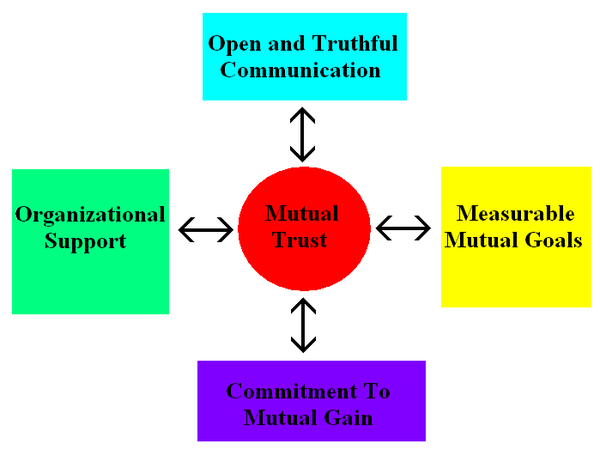| << Chapter < Page | Chapter >> Page > |
The key to every successful partnership is communication and, as a result, technology should be used as a means of increasing communication lines. This may mean using e-mail to interact with customers, or in a much more complex manner, using ongoing data exchange enabled by information technologies designed to increase efficiency. Wal-Mart is a perfect example of a company using technology in a highly sophisticated manner. Wal-Mart has created a competitive advantage through managing their inventory system. Their inventory is systematically programmed to replenish common items as they reach a minimum level. This inventory control system has been central to Wal-Mart maintaining low operating costs and providing competitive advantage through product availability.
Earlier we discussed the importance of trust in a relationship. Trust, however, is only one building block of several involved in the creation of strategic partnerships. This section will briefly introduce five foundational elements and present how they form long-term, successful relationships.
These elements include:

Mutual trust : Not all building blocks are created equally; the most important of the five foundational elements is mutual trust. As previously mentioned, trust is the confidence one party has in another to perform an action as agreed. In order for a partnership to be successful, trust must be mutual. As mutual trust grows between partners, parties will not limit themselves to contractual requirements but actually go to great lengths in order to satisfy the other partner, as well as strengthen the relationship.
Open and truthful communication : An additional element in building long-term, successful, relationships is establishing open and truthful communication lines. Parties that communicate openly and truthfully have a better understanding of each others’ visions, missions and goals in the relationship. One way this can be accomplished is by always creating environments where each party feels comfortable speaking up. Once both partners gain a strong understanding of what motivates the other partner, dealing with changing business conditions becomes significantly easier. Communications often include the exchange of measures of the efficiency of shared business processes.
Measurable, mutual goals : A key element necessary for relationships to be successful is having both parties share measurable, mutual goals. Mutual goals allow parties to pool together company resources and strengths. In order to ensure goals are being met, they must be measurable and quantifiable. Some examples of measurable mutual goals include sales revenue, return on assets, or some performance indicator of customer satisfaction. Measures may also include production levels, error-rates, or other items that enable integration of the businesses processes of the partners. Agreeing on the items to be measured and establishing a continuous measurement program is necessary to provide optimal cooperation among partners and a substantive contributor to establishing mutual trust.

Notification Switch
Would you like to follow the 'Business fundamentals' conversation and receive update notifications?